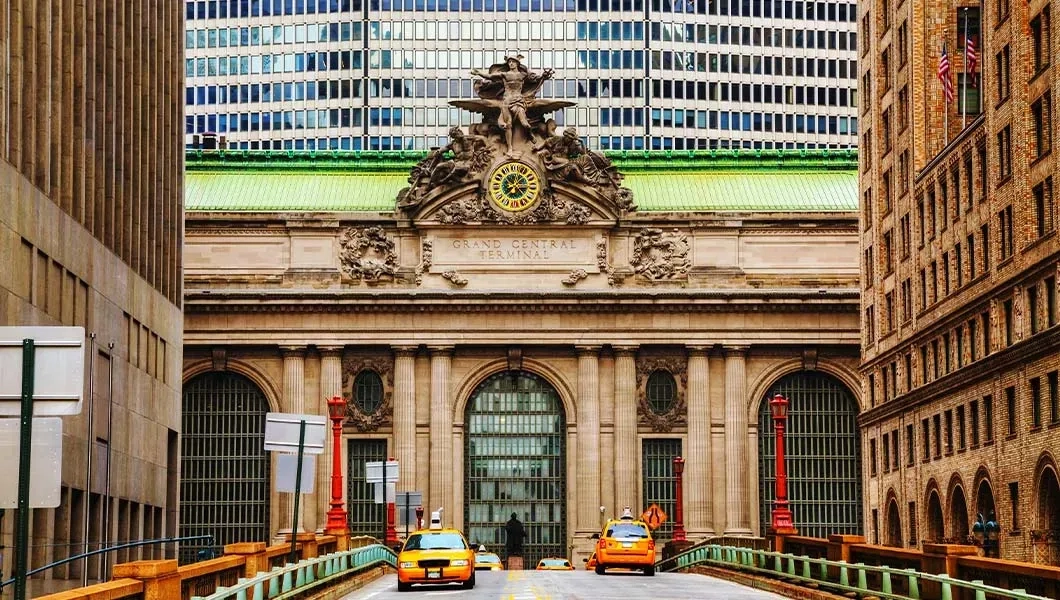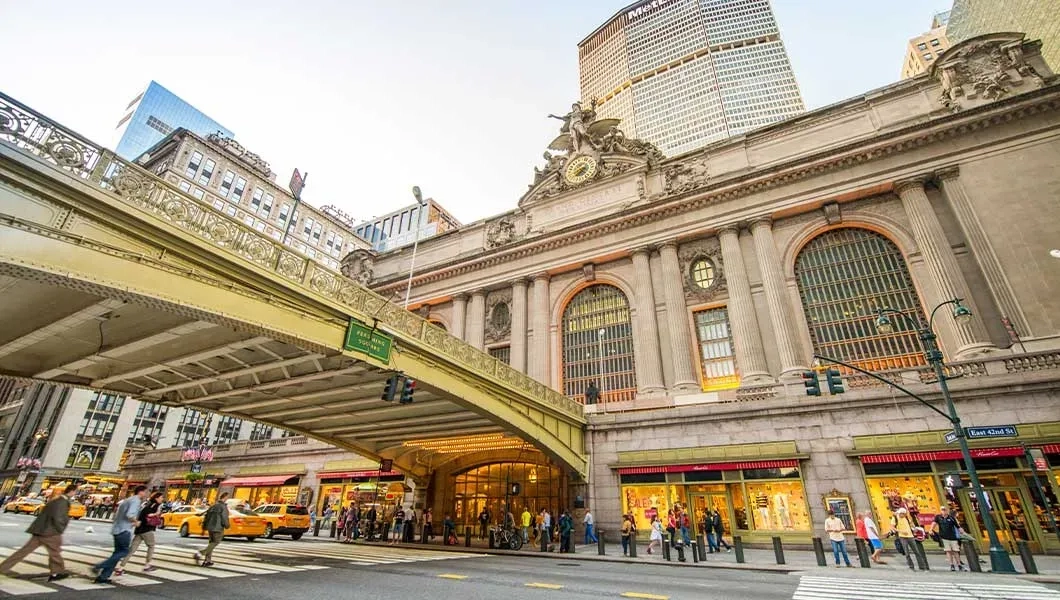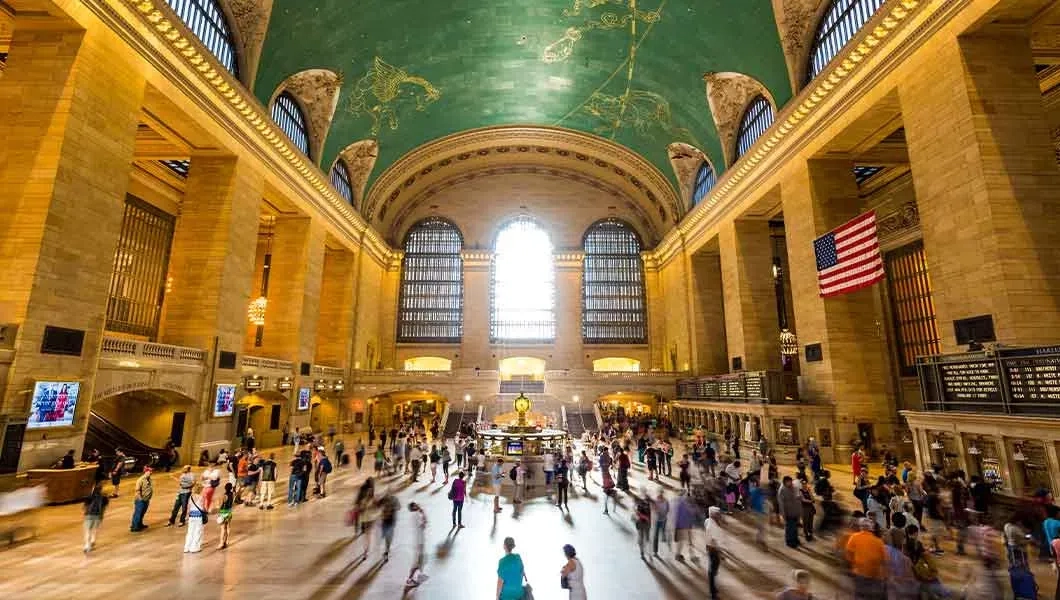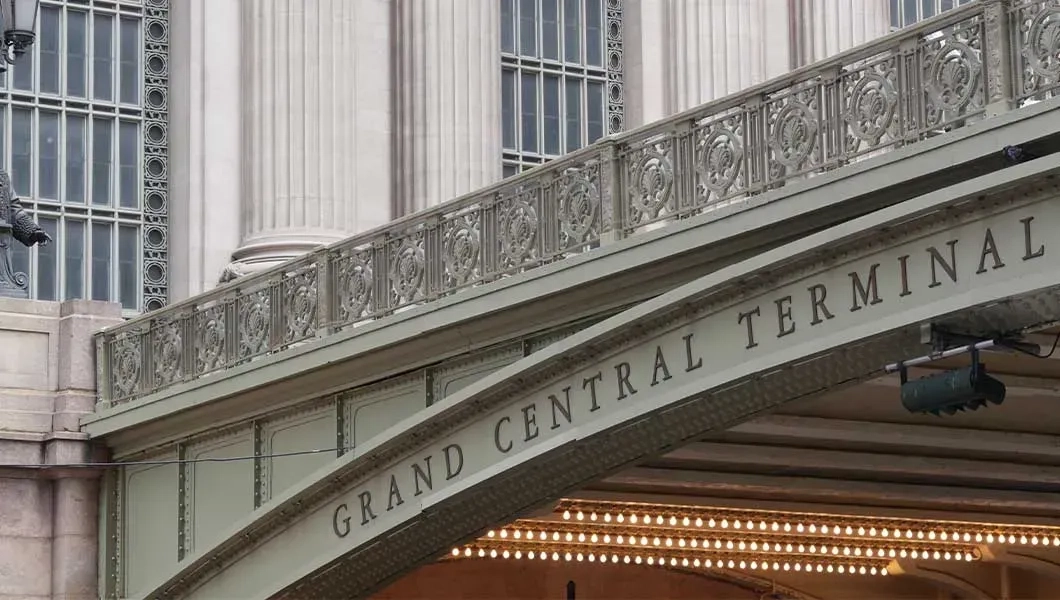My Bookings
Please Enter Your Booking Code To Find Your Booked Tour!
Grand Central Terminal








Overview
Explore this amazing attraction and discover what makes it a must-visit. Stay tuned for more details!
Opening Hours
- Opening Hours
- Open to public daily
- 5:15 AM - 2:00 AM Please note:
- Individual stores, restaurants, the Dining Concourse, and Grand Central Market may have different hours.
- Holiday hours may also vary by establishment within the terminal.
Top Tips
Looks like there are no tips. Be the first one to add a tip to help people enjoy!
Grand Central Terminal is one of New York City’s most iconic landmarks and a masterpiece of Beaux-Arts architecture. It has been a vital transportation hub of the city since 1913, serving the Metro-North Railroad’s Harlem, Hudson, and New Haven lines, as well as the Long Island Rail Road via the new Grand Central Madison. The terminal connects several New York City Subway and bus lines, making it a key node in the city’s transit system.
Spanning 48 acres, Grand Central has 44 platforms and 67 tracks—the most of any station in the world. It has an innovative two-level design that separates commuter and intercity trains for smooth passenger flow. Inside, visitors are greeted by the soaring Main Concourse, famous for its opal-faced clock, celestial ceiling, and grand chandeliers.
Apart from transportation, Grand Central houses a vibrant array of dining, shopping, and cultural experiences. It is a living monument to New York’s history, architectural grandeur, and civic ambition—visited by millions each year.
Top Tips
- Head to the heart of the terminal to admire the iconic celestial ceiling, the Information Booth Clock (worth over $20 million), and the constant buzz of activity. It’s a great photo opportunity and meeting spot.
- Located near the Oyster Bar, this architectural gem allows you to whisper into one corner and be heard diagonally across the room—an acoustic marvel that’s easy to miss.
- For fresh produce, gourmet snacks, and local treats, the Grand Central Market is perfect for a quick bite or souvenir.
- For a more relaxed experience, try to visit in the mid-morning or early afternoon on weekdays. Rush hours (7–9 AM, 4–7 PM) are busiest with commuters.
What to Know
Grand Central Terminal is a transportation hub and an enduring symbol of New York City's innovation, history, and architectural ambition. It was a groundbreaking project that introduced electric traction and a two-level track system, which allowed the seamless separation of commuter and long-distance rail traffic. This innovative design helped shape how major transit centers are built around the world.
The terminal played a crucial role in transforming Midtown Manhattan. By selling the air rights above its tracks, Grand Central enabled the development of office towers and restored the city’s street grid—turning a former rail yard into thriving real estate and civic space.
Its Beaux-Arts architecture, celestial ceiling, and legendary Information Booth Clock have made it one of the most photographed and visited landmarks in the world. Grand Central is a designated National Historic Landmark and a testament to the value of urban preservation.
Today, it serves as a vital transit link between New York and its suburbs while functioning as a cultural, architectural, and historic icon that continues to anchor the city’s identity.
How to Get There
Grand Central Terminal is located at 89 E 42nd Street, New York, NY 10017, right in the heart of Midtown Manhattan. It’s one of the most connected transit hubs in the city, making it easily accessible by train, subway, and bus.
Subway:
Grand Central is served by multiple New York City Subway lines. You can take the 4, 5, 6, 7, or S (Shuttle) lines directly to 42 St–Grand Central Station.
Bus:
Numerous MTA bus routes stop near the terminal, including M1, M2, M3, M4, M42, M101, M102, M103, and Q32. These make Grand Central accessible from nearly every part of Manhattan and nearby boroughs.
By Commuter Rail:
The terminal is the main hub for Metro-North Railroad, with lines running north toward Harlem, Hudson Valley, and New Haven. It’s also now connected to Long Island Rail Road via Grand Central Madison, offering direct service to and from Long Island.
By Foot or Taxi:
If you're staying nearby or sightseeing in Midtown, Grand Central is just a short walk from iconic spots like the Chrysler Building, Times Square, and Bryant Park. Taxis and ride-shares can drop you off directly at the terminal’s main entrance on 42nd Street.
Best Time to Visit
The best time to visit Grand Central Terminal depends on what you’re hoping to experience. For a quieter and more relaxed visit, plan to arrive early in the morning (between 6:00 AM and 9:00 AM) or later in the evening (after 8:00 PM), when the crowds thin out and you can admire the architecture, murals, and hidden gems without the usual hustle.
If you want to see the terminal in full swing, lunchtime on weekdays is ideal. The Main Concourse comes alive with energy as commuters, tourists, and diners mingle. This is also when the Grand Central Market and Dining Concourse are most vibrant.
Weekends tend to be less busy than weekday rush hours and are a good choice for families or casual sightseeing. However, if you’re planning to explore the Grand Central Terminal Tour, visit the Whispering Gallery, or dine at the Oyster Bar, consider weekday afternoons when attractions are open but crowds are manageable.
Visiting during the holiday season (late November to December) adds a magical touch, with seasonal decorations, a holiday market in Vanderbilt Hall, and festive lighting throughout the terminal.
Highlights
Main Concourse & Celestial Ceiling
The heart of the terminal, this massive hall has a stunning vaulted ceiling painted with a reversed constellation map, adorned with over 2,500 stars—59 of them lit by LED. Cornelius Vanderbilt (founder of the Grand Central) claimed this was to give the viewer the divine perspective.
Information Booth and Opal Clock
At the center of the Main Concourse stands the circular Information Booth, topped by a four-faced opal glass clock estimated to be worth over $20 million. This clock, like all those in the terminal, is accurate to within 1 second every 20 billion years, calibrated to the atomic clock in the U.S Naval Observatory in Washington, DC. It’s a favorite meeting point and photo spot.
Whispering Gallery
The arches, which feature Guastavino tile, create an acoustical phenomenon that lets you whisper into one corner and be heard clearly on the opposite side even with all Grand Central Terminal’s hustle and bustle.
Vanderbilt Hall
Originally the main waiting room, this grand Beaux-Arts space now hosts events and exhibitions. During the holidays, it transforms into a festive marketplace.
Grand Central Market
A European-style food market offering gourmet produce, cheeses, meats, and sweets—perfect for a quick bite or artisanal gift.
Campbell Bar
Once a 1920s tycoon’s office, it’s now a glamorous cocktail lounge with soaring ceilings and classic elegance.
Features
Grand Central Terminal is a masterpiece of design and engineering, offering a seamless blend of form, function, and historical innovation. Spanning 48 acres and containing 44 platforms—more than any other station in the world—it operates as both a major commuter rail hub and a world-renowned architectural landmark.
Two-Level Track Design
One of its most groundbreaking features is the dual-level track system, introduced by Chief Engineer William J. Wilgus. This allowed for the separation of long-distance and commuter trains, enhancing operational efficiency and easing passenger flow. With all train lines electrified, the terminal eliminated the smoke and noise associated with steam locomotives.
Pedestrian-Friendly Circulation
Grand Central was the first terminal to use pedestrian ramps on a grand scale, reducing the need for stairways and simplifying navigation. A system of ramps and wide passageways—including the Lexington Passage, Graybar Passage, and 42nd Street Shuttle Passage—connect various parts of the terminal, leading to exits, shops, and platforms. Grand Central North extends pedestrian access all the way to 48th Street via a network of subterranean tunnels.
Architectural Detailing
The terminal’s Beaux-Arts architecture is filled with artistic and symbolic flourishes. Oak leaf and acorn motifs—representing growth and strength—adorn chandeliers, elevator doors, and even the iconic opal clock in the Main Concourse. Exposed light bulbs throughout the terminal highlight the marvel of electric lighting, a novel innovation at the time of its opening in 1913.
Amenities and Accessibility
The Dining Concourse, a lower-level area, offers a mix of casual and gourmet food options including the legendary Grand Central Oyster Bar. The terminal also houses high-end retail stores, public seating areas, free Wi-Fi, accessible elevators, and tactile warning strips for visually impaired visitors.
Cultural and Historical Spaces
Hidden within the terminal are gems like the Campbell Bar—once the private office of a railroad executive—and the Vanderbilt Tennis Club, a public tennis court perched above the Oyster Bar ramp. There's even a former movie theater repurposed into a wine shop, and a railway enthusiast library tucked away on an upper floor.
History and Fun Facts
Grand Central Terminal is a living monument to New York City's evolution, architectural ambition, and cultural identity. It serves as the southern terminus of the Metro-North Railroad's Harlem, Hudson, and New Haven lines. Yet its legacy stretches far beyond the boundaries of transportation.
A Vision Reimagined
The terminal’s history began with two predecessor stations, dating back to 1871. By the turn of the 20th century, growing concerns about the dangers of steam locomotives—especially after a deadly 1902 crash in the Park Avenue Tunnel—led to a major overhaul. Spearheaded by engineer William J. Wilgus, the new plan embraced electric traction and a visionary two-level track system. Construction began in 1903 and, incredibly, rail service continued throughout the ten-year build. Grand Central Terminal officially opened at 12:01 a.m. on February 2, 1913.
Engineering Marvels
Grand Central introduced the use of extensive pedestrian ramps, eliminating most staircases and streamlining passenger movement. Its below-ground design not only made it safer and cleaner, but also created "air rights"—which allowed skyscrapers to be built above the terminal and helped finance the project.
Iconic Design and Features
Designed by the architectural firms Reed & Stem and Warren & Wetmore, Grand Central is a Beaux-Arts masterpiece. The Main Concourse features a celestial ceiling painted with gold-leaf constellations—though they’re famously reversed. Cornelius Vanderbilt, the station’s financier, claimed it was meant to reflect the view from a divine perspective. At the center sits the famed four-faced opal clock, valued at over $20 million.
Cultural Icon
Grand Central has appeared in countless films and television shows, reinforcing its iconic status. It’s one of the top ten most-visited tourist attractions in the world, drawing over 21 million people annually—excluding train and subway passengers.
Fun Facts
- Grand Central holds the Guinness World Record for most platforms: 44 across two levels.
- Track 61, beneath the Waldorf Astoria, was once used as a secret entrance by President Franklin D. Roosevelt.
- Every light bulb in the terminal is intentionally left exposed to showcase the marvel of electricity—a cutting-edge feature at the time of its debut.
- A full hospital once operated inside Grand Central for workers and passengers alike.Over a century since its opening, Grand Central Terminal remains a marvel of design and utility—simultaneously a transportation hub, shopping center, historic site, and cultural touchstone. Whether you're passing through or staying to explore, it’s a place where New York’s past, present, and future converge under one iconic roof.
Quick Links
Book your Tour
Get in Touch
Toll Free
1-888-961-6584
Local
1-289-271-9767
© 2025 See Sight Tours. All Rights Reserved.
1-888-961-6584

